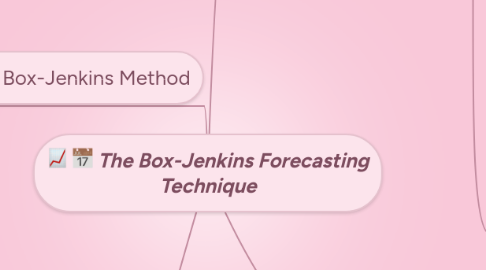
1. The Box-Jenkins Method
1.1. Stochastic-Dynamic Box-jenkins Models
1.1.1. General Considerations
1.1.1.1. The behavior of the variable of primary interest (the endogenous variable, or variable we wish to forecast) is related not only to its past behavior, but to the behavior of other (exogenous) variables as well.
1.1.2. Identification of structure
1.1.2.1. Develop a stochastic model for an exogenous variable and then use this model as a "filter" to transform the exogenous variable to a "white noise" series. This same filter is also applied to the variable of primary interest.
1.1.3. Process Control Applications
1.1.3.1. ECONOMIC: observe but not manipulate the ecogenous variables
1.2. Stochastic Box-Jenkins Models
1.2.1. Estimation of the model
1.2.1.1. The current observation is represented by a linear combination (weighted average) of previous observations, plus anerror term associated with the current observation, plus a linear combination of error terms associated with previous observations. The error terms have zero mean, constant variance, and are uncorrelated with each other. The portion of the model involving the observations is called theautoregressivepart of the model, and the portion involving the error terms is calledthe moving average part of the model
1.2.2. Derivation of the optimal forecaster
1.2.2.1. In order to determine a forecaster from a model, it is necessary to specify a criterion which the forecaster satisfie
2. Aplications
2.1. Purely Stochastic Models
2.1.1. Suited for development of models of processes exhibiting strong seasonal behavior
2.2. Stochastic-Dynamic Models
2.2.1. As we increase the number of exogenous variables in the model we increase the data requirements of the model
3. Previous Techniques
3.1. Forecasters Derived from Tested Mathematical Models
3.1.1. Model Building Process
3.1.1.1. SELECTION OF A GENERAL MODEL CLASS. First there must be available a class of models which is capable of exhibiting the essential characterstics os the process under study.
3.1.1.2. MODEL INDENTIFICATION. A preliminary analysis of the problem under study will suggest a tentative subclass of models which is reasonable to entertain.
3.1.1.3. MODEL FITTING. Observed data are used to "fit" one of these models.
3.1.1.4. DIAGNOSTIC CHECKING. The fitted model is subjected to a number of diagnostic checks to test wether the model is an adequate representation of the process.
3.1.2. Classes of models
3.1.2.1. Dynamic/ Causal/ Econometric models
3.1.2.1.1. Relate the behavior of the variable of primary interest to the behavior of the other variables
3.1.2.2. Stochastic/ Empirical models
3.1.2.2.1. Develop a model which exhibits the same essential characteristics as the porcess under study without attempting to identify the causal nature of the relationships between various relevant interacting variables.
3.2. Intuitive Methods
3.2.1. Smoothing
3.2.1.1. Smoothing methods represent attempts to determine some sort of "average" value around which the observations appear to be fluctuating. (Moving average & Exponential smoothing)
3.2.2. Curve fitting
3.2.2.1. A graph of the history of any process generally contains characteristic "patterns" which appear over and over.Although quadratic-like curves often occur throughout the graph, any attempt to forecast by extrapolating these curves will result in forecast errors
